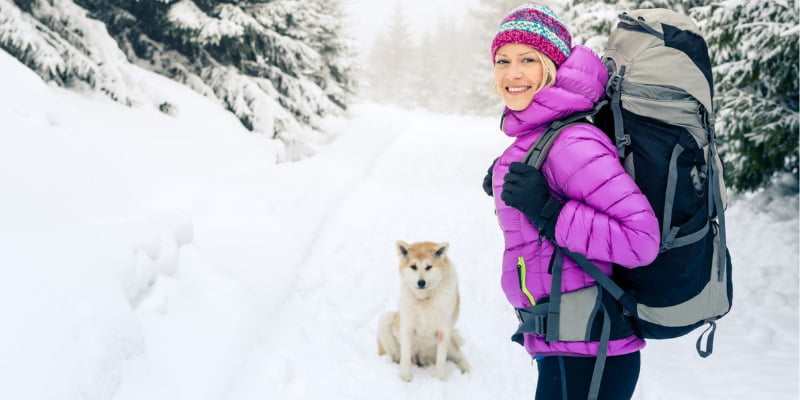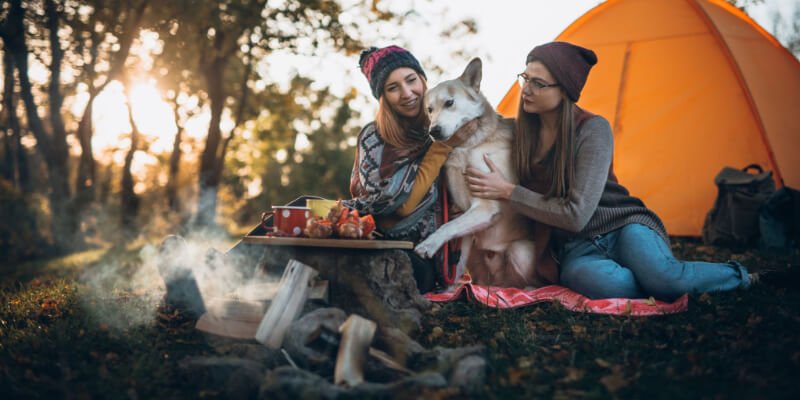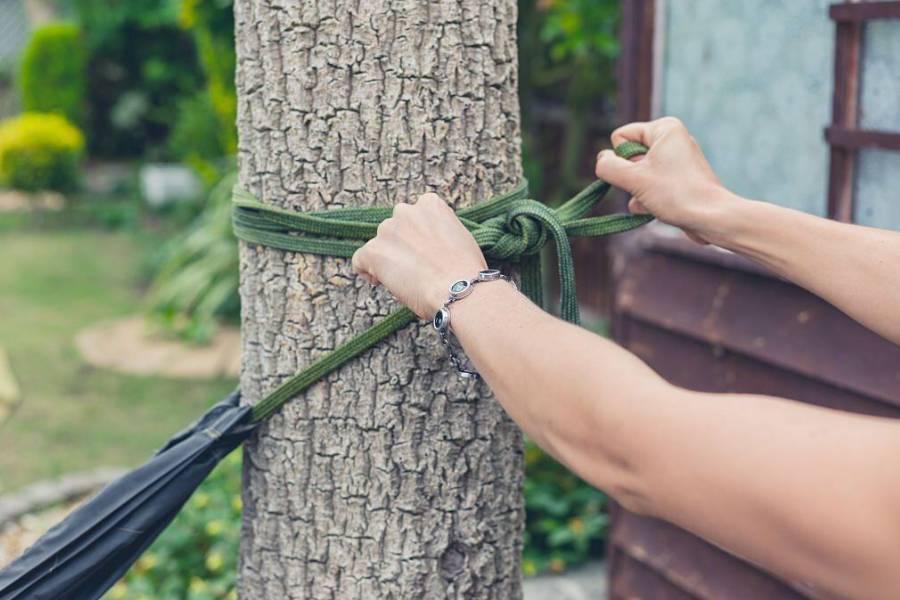12 Useful Tips for Winter Camping with a Dog

Winter camping offers a peaceful retreat from the everyday hustle, and it’s even better when you can share the experience with your dog. With the right preparation and precautions, your canine companion can safely join you on this snowy adventure. To help ensure a successful trip, here are 12 essential tips and tricks to consider before heading out on a winter camping excursion with your dog. These guidelines will help both of you stay comfortable, safe, and enjoy the beauty of a winter landscape together.
1. Not every dog is well-suited for winter camping
The first and most crucial consideration when planning a winter camping trip with your dog is determining whether your dog is suited for cold-weather conditions. Even if your dog enjoys cooler temperatures, you need to ensure they can handle prolonged exposure to cold. Certain breeds are naturally better equipped for snowy adventures. Some of the most popular cold-loving breeds include:
- Newfoundland
- Siberian Husky
- St. Bernard
- Chow chow

While some dog breeds are well-suited for winter camping, others face significant challenges when exposed to snow and cold temperatures. Dogs with short fur or no fur at all are particularly vulnerable, as they lack the natural insulation needed to stay warm. Breeds that struggle in icy conditions include:
- Chihuahua
- French bulldog
- Greyhound
However, it’s not just the breed that matters—your dog’s behavior in cold weather can also give you important clues about their suitability for winter camping. Have you noticed your dog avoiding the cold or snow in the past? Maybe they enjoy a brief romp in the snow but quickly retreat to the warmth of a fireplace. If this sounds familiar, winter camping in colder climates might not be the best choice for your furry friend. In these cases, a camping trip to a warmer, southern destination can help prevent frustration and protect your dog from the dangers of hypothermia.
2. Recognize when it’s too cold for your dog
It depends largely on the breed of the dog. However, temperatures below -5 degrees Celsius are critical for longer outdoor activities. If it is less than -10 degrees Celsius, it can be life-threatening. The following table is based on the data and surveys of Tufts Animal Condition and Care (TACC) and provides a rough direction when caution is required. If your overall result is “in the green,” meaning a value of 1 or 2, outdoor activities with your dog are generally safe, even for extended periods.
Also, note the modifiers below the table:
| ° C | Small Dog | Medium Dog | Big Dog |
| 15th | 1 | 1 | 1 |
| 12th | 1 | 1 | 1 |
| 10 | 2 | 1 | 1 |
| 7th | 2 | 2 | 1 |
| 4th | 3 | 3 | 2 |
| 1 | 3 | 3 | 3 |
| -1 | 3 | 3 | 3 |
| -4 | 4th | 4th | 3 |
| -6 | 5 | 4th | 3 |
| -9 | 5 | 4th | 4th |
| -12 | 5 | 5 | 5 |
| -15 | 5 | 5 | 5 |
| -17 | 5 | 5 | 5 |
Influencing factors and the change in the table values:
- Wet weather: +2
- Protective clothing: -1
- Nordic dog breed: -1
- Dog is used to the cold: -1
Total values and their meaning:
- Total score 1: No sign of danger or risk from cold to the animal. Have fun outdoors as much as you want!
- Overall value 2: Risk of cold unlikely, continue to have fun! But watch your dog’s behavior to be on the safe side.
- Overall score 3: Depending on the breed, it can be dangerous. Keep a close eye on your animal outdoors.
- Overall rating 4: Dangerous weather conditions, exercise caution, and limit outdoor activities.
- Overall rating 5+: Potentially life-threatening cold! Keep outdoor activities to a minimum. If possible, limit it to a few minutes.
How do you read the table A practical example:
Your dachshund may not be a Nordic breed, but having lived in the Swiss Alps for years, he’s accustomed to the cold (-1). However, you’re on a spontaneous trip without protective gear, and the campsite is muddy and snowy (+2). Adjusting for these factors (+2-1), you modify the result by +1.
With temperatures at 4°C and thawing snow, and considering your dachshund is a small breed, you reference a value of 3 from the table. After applying the +1 modification, the total value reaches a critical 4. With this result, it’s important to be cautious, as extended outdoor exposure could pose a risk to your dog in these conditions!
3. Keep your four-legged friend warm

Make sure that your dog does not freeze. Dogs can also catch a cold or become very hypothermic. Pay attention to the following points to keep your four-legged friend warm:
- Always use a warming insulation layer on cold floors, especially in the tent.
- Give your pet more food when it gets cold outside. That gives extra energy.
- Watch for signs your dog is freezing, like whimpering, trembling, lethargy, or restlessness.
4. Make sure to see your dog more easily in the dark
In winter camping, darkness falls much earlier, so walks with your dog often happen at night. While this isn’t usually a big deal, losing sight of your dog in the dark can be dangerous—especially near roads where a wandering dog could get hurt. Safety comes first, and one of the best solutions is a smart gadget I mentioned in a previous article on camping accessories. It comes in three colors, which is especially handy if you’re camping with multiple dogs. You can assign a color to each one, making it easier to spot them in the dark.
5. Drinking water must not freeze

It’s crucial to ensure your dog’s drinking water doesn’t freeze in cold weather. During winter walks, always provide access to fresh water. When winter camping, one of the first things to check each morning is your water supply. If you find ice in the bottles, heat the water on a gas stove before offering it to your dog.
Can my dog eat snow?
While snow is not a substitute for drinking water, it’s important to prevent your dog from eating large amounts of it.
Why shouldn’t my dog eat snow?
A small amount of snow isn’t harmful, but consuming too much can cause stomach irritation or diarrhea, especially if the snow is contaminated with road salt or dirt. Always offer lukewarm water, which can reduce your dog’s desire to eat snow. If your dog frequently eats snow, you may need to intervene to prevent it.
6. Keep your dog dry at all times, especially at night
Towels and brushes are essential items for winter camping with dogs. Walks in the mud, romp around in the snow, or swim in the lake – many activities leave your coat damp. Without aids, it takes a long time until your dog is dry again and can thus better defy the cold.
If you brush your four-legged friend vigorously and rub it dry with towels, you will prevent hypothermia. Your fur nose warms up faster and you have the advantage that less dog hair gets into the tent or camper. Even a Chow-Chow is insensitive to cold and can freeze if cold and wet complement each other over a longer time.
7. Additional clothing such as towels and blankets
The golden rule for winter camping: the more blankets and towels you take, the better prepared you are for all conceivable cases. Sure it costs a little more space in the motorhome or RV, but it makes your adventure a lot easier:
- More underlay means more protection from the cold, which is particularly important for tent floors. You should also take precautions if older campers are poorly insulated.
- If the first dog coat or sleeping bag gets damp, replace it and dry it off. The replacement equipment prevents the fur from becoming damp and therefore cold.
- Towels and blankets help against unpredictable events. If the tent suddenly leaks, you at least have a replacement for such emergencies with you.
8. Ensure your dog is familiar with a campfire

Not every dog is used to open fire. So if you plan to light a campfire in the cold season, you should get your dog used to fire pits before traveling. There are enough public events or festivities for which a fire is lit (Easter bonfires, medieval markets, fire pits at festivals, etc.). Take your furry friend with you on such occasions and watch and monitor him closely.
9. Protect dog paws in winter
One of the dangers of camping for dogs is the ground itself. If a campsite isn’t dog-friendly, it can pose risks for your furry friend. For instance, gravel surfaces can be painful for a dog’s paws and increase the risk of injury. Even in winter, when deep snow covers the ground, it’s important to choose dog-friendly sites to avoid hazards.
In addition to sharp objects like broken glass, thorns, and splinters, dogs are also at risk from road salt, which can irritate their paws. A great solution is robust dog shoes, which protect against injuries and the cold while keeping their paws dry.
10. Plan more dog hair in the camper when changing fur

When your dog starts growing their winter coat in autumn, you can expect an increase in shedding. Dogs typically go through shedding cycles every 6-8 weeks, which can lead to more hair on the floor. Plan for this when traveling with your dog in the fall.
The amount a dog sheds also varies by breed, age, and hormone status. Older dogs tend to shed more, and neutered pets may lose more hair than their intact counterparts. To minimize hair in your camper or tent, brush your dog thoroughly and dry them with a towel after outdoor activities. This helps keep the hair outside where it belongs.
11. Dog also needs sufficient exercise in winter
Regardless of the weather—rain, snow, sunshine, or autumn storms—your dog needs regular outdoor exercise. Although it might not always be pleasant for you, especially during cold walks at -5 degrees, it’s essential for your dog’s well-being.
Keep in mind that during winter camping, your dog will likely be less active than in summer, when you spend more time outdoors together. In a motorhome or RV, your dog has less space to move around, which can lead to a lack of exercise if not addressed. To prevent this, brace yourself for those necessary walks and look forward to the warmth of the heater or the comfort of your partner afterward!
12. Suitable mobile homes and RVs for winter camping with a dog
My final tip is to research the right motorhome thoroughly if you’re considering renting one with your dog. Keeping your furry friend a secret can lead to complications, as many landlords are not keen on dog hair, which could result in disputes and extra costs. Make sure to find out which landlords accept dogs before renting.
The best option is to look for motorhomes specifically designed for dog owners. These specially designed models often feature clever layouts that prioritize dog-friendly accommodations.
Conclusion
Embarking on a winter camping adventure with your canine companion can be a rewarding experience, enhancing the bond between you and your loyal friend. Always prioritize your dog’s safety and comfort in the cold. A well-equipped dog is one with happy, healthy paws! Ultimately, it’s your responsibility to select the most suitable chamber for your trip. My preference varies between lodging and camping, depending on the destination and activities planned with my dog.
I hope this guide has been helpful! If you have any questions, feel free to leave a comment below.
Find all our equipment tips for dogs here.







whoah this blog is wonderful i really like reading your articles. Keep up the great paintings! You realize, a lot of people are hunting round for this info, you could help them greatly.